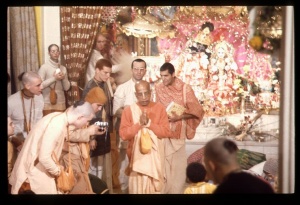CC Adi 5.30 (1975)

A.C. Bhaktivedanta Swami Prabhupada
Below is the 1996 edition text, ready to be substituted with the 1975 one using the compile form.
TEXT 30
- sālokya-sāmīpya-sārṣṭi-sārūpya-prakāra
- cāri mukti diyā kare jīvera nistāra
SYNONYMS
sālokya—the liberation called sālokya; sāmīpya—the liberation called sāmīpya; sārṣṭi—the liberation called sārṣṭi; sārūpya—the liberation called sārūpya; prakāra—varieties; cāri—four; mukti—liberation; diyā—giving; kare—does; jīvera—of the fallen souls; nistāra—deliverance.
TRANSLATION
He delivers the fallen living entities by offering them the four kinds of liberation—sālokya, sāmīpya, sārṣṭi and sārūpya.
PURPORT
There are two kinds of liberated souls—those who are liberated by the favor of the Lord and those who are liberated by their own effort. One who gets liberation by his own effort is called an impersonalist, and he merges into the glaring effulgence of the Lord, the brahmajyoti. But devotees of the Lord who qualify themselves for liberation by devotional service are offered four kinds of liberation, namely sālokya (status equal to that of the Lord), sāmīpya (constant association with the Lord), sārṣṭi (opulence equal to that of the Lord) and sārūpya (features like those of the Lord).